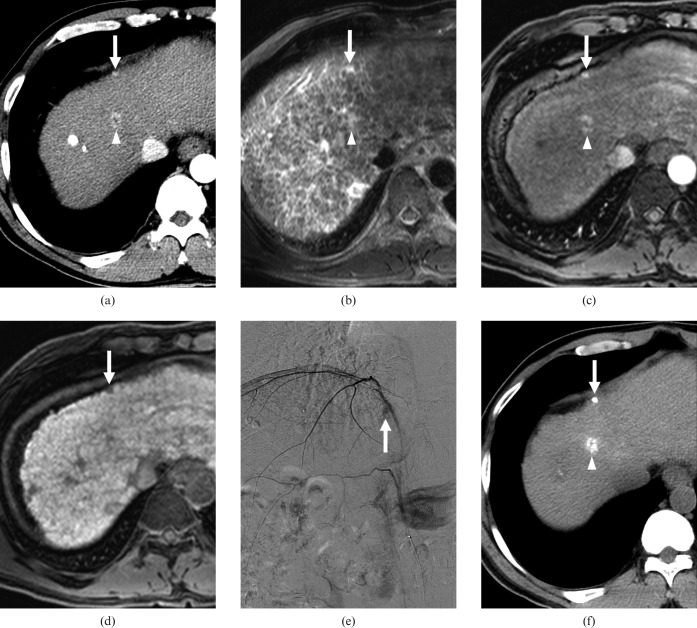Figure 2.
A 43-year-old male with a history of transcatheter arterial chemoembolisation (TACE) for hepatocellular carcinomas (HCCs) and two (1.4 and 0.6 cm in diameter) recurrent HCCs. (a) Contrast-enhanced CT scan obtained on arterial phase shows a hypervascular nodule of 1.4 cm diameter in the border of segments IV and VIII (arrowhead) and a hypervascular nodule of 0.6 cm diameter in segment IV (arrow). On contrast-enhanced CT scan obtained on equilibrium phase at same level as (a), the nodule in the border of segments IV and VIII showed a washout pattern, while the nodule in segment IV showed no washout pattern (not shown). All observers interpreted the nodule in border of segment IV and VIII as a HCC and the nodule in segment IV as arterioportal shunt. (b) T2 weighted MR image shows two hyperintense nodules in the border of segments IV and VIII (arrowhead) as well as in segment IV (arrow). (c) Gadoxetic acid-enhanced arterial phase MR image shows two hypervascular nodules in the border of segments IV and VIII (arrowhead) and segment VI (arrow). On gadoxetic acid-enhanced 3-min late phase MR image at the same level as (c), the nodules in the border of segments IV and VIII and in segment IV showed a washout pattern (not shown). (d) Gadoxetic acid-enhanced hepatobiliary phase MR image shows two hypointense nodules in the border of segments IV and VIII (not shown) and in segment IV (arrow). All observers interpreted the two nodules as HCCs. (e) Right inferior phrenic angiography shows hypervascular tumour staining (arrow) in segment IV. The nodule in the border of segments IV and VIII also revealed hypervascular tumour staining on hepatic arteriography (not shown). (f) Unenhanced CT scan obtained after TACE shows iodised-oil accumulation at the corresponding nodules in the border of segments IV and VIII (arrowhead) and in segment IV (arrow).

